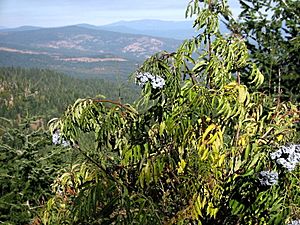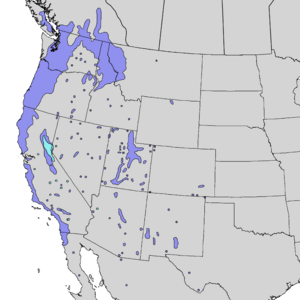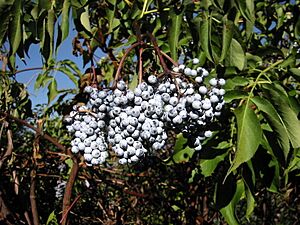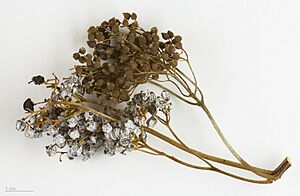Sambucus cerulea facts for kids
Quick facts for kids Sambucus ceruleaSambucus nigra subsp. cerulea |
|
|---|---|
 |
|
| Scientific classification | |
| Genus: |
Sambucus
|
| Species: |
cerulea
|
 |
|
| Natural range of Sambucus cerulea (including S. velutina in lighter blue) | |
| Synonyms | |
|
Sambucus nigra subsp. cerulea |
|
The blue elderberry (scientific name: Sambucus cerulea) is a type of shrub or small tree. It is also known as the blue elder. This plant belongs to the elderberry family, which is called Adoxaceae. You can find it growing in many parts of western North America.
Contents
What is Blue Elderberry Called?
The blue elderberry has a few different scientific names. Its main name is Sambucus cerulea. However, some experts, like those at the United States Department of Agriculture (USDA), call it Sambucus nigra subsp. cerulea. This means it's seen as a subspecies of the black elderberry.
Other names you might hear for it include Sambucus mexicana or Sambucus caerulea. In the past, it was also called Sambucus glauca. All these names refer to the same plant!
Where Does Blue Elderberry Grow?
Blue elderberry plants are native to the Western United States, northwestern Mexico, and British Columbia in Canada. They grow from the Pacific coast all the way to states like Montana, Wyoming, Texas, and Oklahoma.
You can find these plants in many different places. They grow in mountains, valleys, and along rivers. They also like open areas in forests and on sunny slopes where they can get enough moisture. They can grow at elevations up to about 9,800 feet (3,000 meters).
What Does Blue Elderberry Look Like?
The blue elderberry is a large shrub that loses its leaves in winter. It can grow up to 30 feet (9 meters) tall and 20 feet (6 meters) wide. It usually grows with several stems, giving it a wild look. You can trim it back a lot in winter when it's not growing.
One special thing about this elderberry is the powdery blue coating on its berries. This coating makes the berries look bluish-black.
Leaves, Flowers, and Berries
The leaves of the blue elderberry are smooth and have sharp, pointed edges. They are shaped like an oval or a spear. Each leaf is usually about 1 to 6 inches (3 to 15 cm) long and 1 to 2 inches (2 to 6 cm) wide.
In May and June, the plant produces many white or cream-colored flowers. These flowers grow in flat-topped clusters that are about 2 to 8 inches (5 to 20 cm) wide. The flowers have a strong smell, which some people find unpleasant. Each tiny flower is about 0.15 to 0.27 inches (4 to 7 mm) wide.
The fruits are small, round, and juicy berries. They are about 0.15 to 0.23 inches (4 to 6 mm) across. They look bluish-black because of the pale, powdery blue coating. Inside each berry, there are 3 to 5 small, seed-like stones, each holding a single seed.
How is Blue Elderberry Used?
Blue elderberry plants have many uses! The flowers can be used to make a type of tea. The berries can be eaten fresh, dried, or made into jelly. However, it's important to know that eating too many raw berries might make some people feel a little sick.
Traditional Uses by Native Americans
Many Indigenous peoples of North America have used blue elderberry for a long time. They used the leaves, flowers, bark, roots, and wood for traditional medicines. These remedies could be taken internally or put on the body. Fresh, dried, and cooked berries were also an important food source.
Some tribes used the wood to make musical instruments like flutes and whistles. The soft wood was even used to start fires by rubbing sticks together. The bark was used to make a remedy for fevers. The stems and berries were also used to create dyes for basket weaving.
For example, the Concow tribe in California called the plant "nō-kōm-hē-i′-nē" in their language.
Growing Blue Elderberry in Gardens
Blue elderberry is also grown as an ornamental plant in gardens. People plant it in traditional gardens, native plant gardens, and gardens designed to attract wildlife. It's also used in projects to restore natural habitats. If you train it when it's young, it can even grow into a small tree with several main trunks.
This plant is great for wildlife gardens! Its flowers attract helpful insects like pollinators, as well as butterflies and hummingbirds. The berries are a food source for many bird species and small animals like chipmunks.
Images for kids
-
In southern California's Antelope Valley
See also
 In Spanish: Sambucus cerulea para niños
In Spanish: Sambucus cerulea para niños




